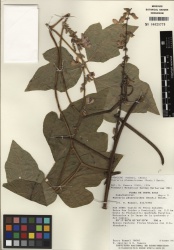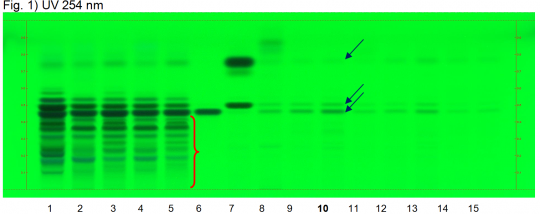Pueraria spp. (root)
Contents |
Nomenclature
Botanical Voucher Specimen
|
|
Organoleptic Characteristics
Macroscopic Characteristics
Microscopic Characteristics
High Performance Thin Layer Chromatographic Identification
|
Kudzu root, ge gen (root) (Pueraria montana var. lobata) Lane Assignments Lanes, from left to right (Track, Volume, Sample):
Reference Sample(s) Reference: Dissolve 1 mg of daidzin and 1 mg of puerarin individually in 1 mL of methanol. Optional: Dissolve 1 mg of daidzein in 1 mL of methanol. Stationary Phase Stationary phase, i.e. Silica gel 60, F254 Mobile Phase Dichloromethane, ethyl acetate, methanol, water 20:40:22:10 (v/v/v/v)--NOTE: to avoid the formation of two phases respect this order when mixing the mobile phase. Sample Preparation Method Sample: Mix 500 mg of powdered sample with 5 mL of methanol and sonicate for 10 minutes, then centrifuge or filter the solutions and use the supernatants / filtrates as test solutions. Detection Method Saturated chamber; developing distance 70 mm from lower edge; relative humidity 33% Other Notes Images presented in this entry are examples and are not intended to be used as basis for setting specifications for quality control purposes. System suitability test: Puerarin: dark quenching zone at Rf ~ 0.48; Daidzin: dark quenching zone at Rf ~ 0.51 Identification: Compare result with reference images. The fingerprint of the test solution is similar to that of the corresponding botanical reference sample. Additional weak zones may be present. The chromatogram of the test solution shows intense quenching zones corresponding to reference substances puerarin and daidzin (red arrows). Below the zone corresponding to puerarin there are at least 5 quenching zones of medium intensity (orange arrow). Above the zone corresponding to daidzin there are 1 to 2 distinct quenching zones. At Rf ~ 0.75 there is a weak zone corresponding to reference standard daidzein. Test for other species: The chromatogram of Thomson’s kudzu root shows only two weak quenching zones corresponding to reference substances puerarin and daidzin.
|
|
Thomson’s kudzu root, gen ge (root) (Pueraria montana var. chinensis) Lane Assignments Lanes, from left to right (Track, Volume, Sample):
Reference Sample(s) Reference: Dissolve 1 mg of daidzin and 1 mg of puerarin individually in 1 mL of methanol. Optional: Dissolve 1 mg of daidzein in 1 mL of methanol. Stationary Phase Stationary phase, i.e. Silica gel 60, F254 Mobile Phase Dichloromethane, ethyl acetate, methanol, water 20:40:22:10 (v/v/v/v); NOTE: to avoid the formation of two phases respect this order when mixing the mobile phase. Sample Preparation Method Sample: Mix 500 mg of powdered sample with 5 mL of methanol and sonicate for 10 minutes, then centrifuge or filter the solutions and use the supernatants / filtrates as test solutions. Detection Method Saturated chamber; developing distance 70 mm from lower edge; relative humidity 33% Other Notes Images presented in this entry are examples and are not intended to be used as basis for setting specifications for quality control purposes. System suitability test: Puerarin: dark quenching zone at Rf ~ 0.48; Daidzin: dark quenching zone at Rf ~ 0.51. Identification: Compare result with reference image. The fingerprint of the test solution is similar to that of the corresponding botanical reference sample. Additional weak zones may be present. The chromatogram of the test solution shows weak quenching zones corresponding to reference standards puerarin and daidzin (black arrows). Below the zone corresponding to puerarin there are no or only very weak quenching zones. At Rf 0.75 there may be a weak zone corresponding to reference standard daidzein. Test for other species: No intense zone is seen between the zone corresponding to puerarin and the start position (red arrow, Kudzu root).
|
Supplementary Information
Sources
- ↑ MOBOT, Tropicos.org http://www.tropicos.org/Image/81216
- ↑ HPTLC Association http://www.hptlc-association.org/
- ↑ HPTLC Association http://www.hptlc-association.org/


